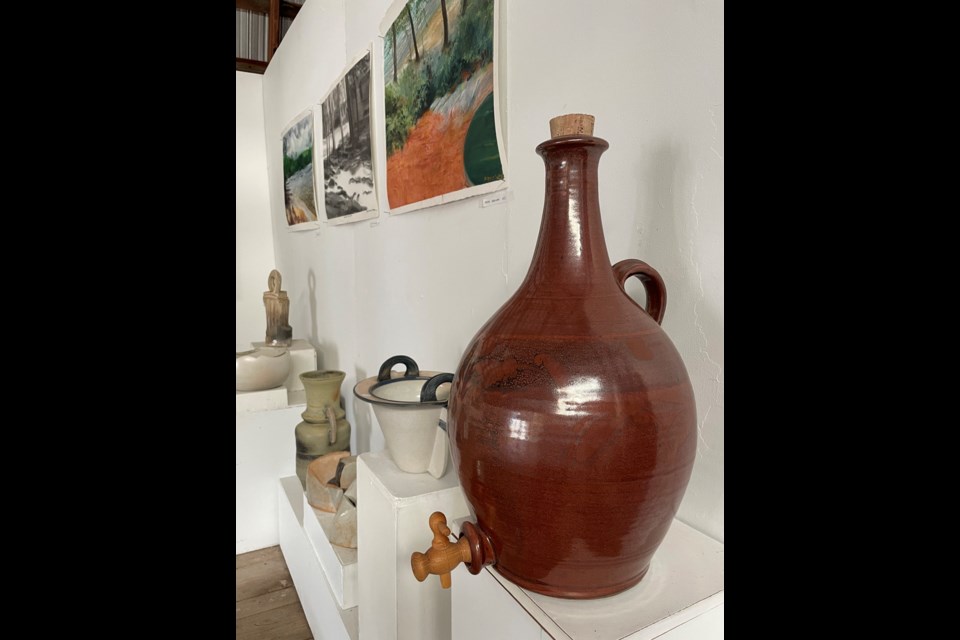After almost 50 years of producing award-winning ceramics, Kerslake Pottery in Oro-Medonte is beginning a new era. The local pottery recently celebrated its upcoming milestone with a final firing of its large fuel-burning kiln.
“We will continue to make pots,” explained ceramic artists Heather and Roger Kerslake, "but not in the same way as we have in the past.”
The couple, who work from their iconic studio/barn in Jarratt, near Orillia on Horseshoe Valley Road, have been leaders in creating the rich artistic community we enjoy in this area. They are now taking a step to change the way they work.
Heather said there are two factors responsible for the change, with the climate crisis being a significant one.
“Our environment has changed and we need to adapt how we do things in the midst of our climate crisis. When we fire our kiln, using natural gas, it takes an entire day to heat up and then needs to cool for up to 48 hours.”
Roger estimates that each firing emits about as much carbon as driving from Jarratt to Toronto — and back.
The Kerslakes acquired the kiln about 30 years ago from another pottery studio and rebuilt it to suit their needs. It is known as a “car” kiln because it is built on a track that allows the unit to be pulled in and out, making it easier to use than a top-loading kiln. The kiln uses a reduction firing method, which produces rich organic and earthy tones in the pottery. The atmosphere can be controlled by the potter to achieve different effects from the glazes.
“The results we get with our large fuel-burning kiln are distinct from those we get using a smaller electric kiln,” explained Heather. “We have been able to fire larger pieces such as the one-of-a-kind vessels that Roger has created over the years. These are special pots that use traditional craftmanship skills and cannot be recreated.”
“I’ve never been a production potter,” said Roger. “Although I’m a good thrower, a lot of my work isn’t thrown. I like individual pieces made by a slower process of coiling, slabbing and pinching.”
Creating these large sculptures and vessels requires a fair amount of strength and stamina, which is the second factor that is having an impact on the type of work produced at the pottery.
Maintaining a career into your mid-80s (Roger just turned 84) is quite the accomplishment, but also affects the kind of work he is able to produce.
“I have often used up to 28 pounds of clay for one piece,” noted Roger. “You need a fair amount of strength and dexterity to work with these amounts on a spinning potter’s wheel.”
Eliminating the use of the large kiln that burns fossil fuels seems to be a timely decision, suited to a more practical and environmentally friendly way of producing pottery.
“Art reflects the time the artist is living in,” Heather commented. “The trends, fashion, technology — it’s all reflected in the art and makes what we do authentic. We know that the pots coming out of this kiln are special, with the beauty of glazes that you can only do with a reduction kiln.
“When Roger emigrated to Canada from England in 1970, it was really a golden age of bringing potters back into the community,” said Heather.
Bringing with him the traditional skills learned from master potters and university studies in England, Roger began his career in Canada as a ceramics instructor at Central Technical School in Toronto before becoming the coordinator of the Material Arts Program at Georgian College. It was in this position where he trained and mentored a number of highly successful potters who have contributed to the local artistic community and beyond.
Kerslake Pottery was a founding member of the long-running Images Studio Tour in Simcoe County. Roger’s works of art have also been featured in galleries and travelling exhibitions, including a retrospective show in 2015/16 that also highlighted the work of Roger’s students. His stunning pots and sculptures can be found all over the world — in art galleries, museums (including the Royal Ontario Museum), and in many private collections.
“What I find most exciting about my work is opening the kiln and seeing all the things that make good pots – the surface texture, density and form – the things that make you want to look at it pick it up and invite you to touch,” said Roger.
He admits that it is sometimes difficult to part with a pot that has all these special characteristics. But he also says there is nothing nicer than buying from the artist.
“You can delve into the piece, finding out about the artist and why and how it’s been made," he explained. “My marks are on these pieces and they present themselves in different ways. If someone can respond to that and sense this, then I am quite happy to sell it.”
Heather echoed those sentiments.
“We love to share our love of ceramics with others and look forward to continuing to celebrate the beauty of what we produce here,” added Heather. “With the final firing of our large kiln, it’s a perfect time for people to see the range of work that we’ve been fortunate to be able to create over the years.”
To learn more about Kerslake Pottery, visit https://www.facebook.com/kerslakepottery.
